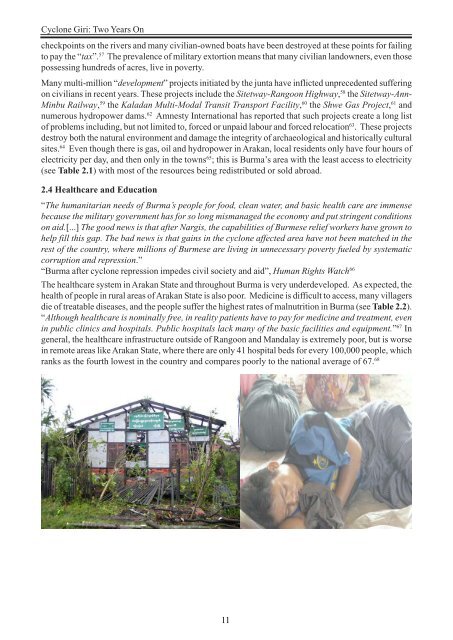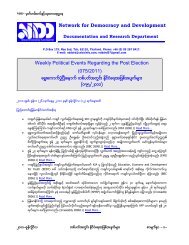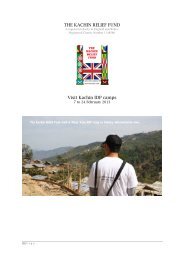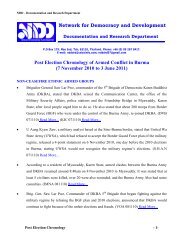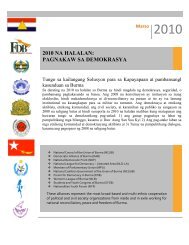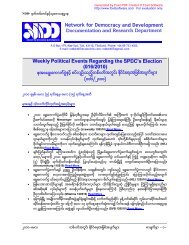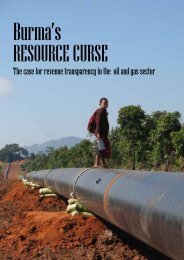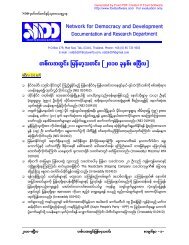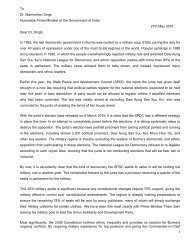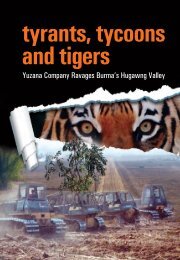Cyclone Giri - Two Years On - Burma Action Ireland
Cyclone Giri - Two Years On - Burma Action Ireland
Cyclone Giri - Two Years On - Burma Action Ireland
You also want an ePaper? Increase the reach of your titles
YUMPU automatically turns print PDFs into web optimized ePapers that Google loves.
<strong>Cyclone</strong> <strong>Giri</strong>: <strong>Two</strong> <strong>Years</strong> <strong>On</strong><br />
checkpoints on the rivers and many civilian-owned boats have been destroyed at these points for failing<br />
to pay the “tax”. 57 The prevalence of military extortion means that many civilian landowners, even those<br />
possessing hundreds of acres, live in poverty.<br />
Many multi-million “development” projects initiated by the junta have inflicted unprecedented suffering<br />
on civilians in recent years. These projects include the Sitetway-Rangoon Highway, 58 the Sitetway-Ann-<br />
Minbu Railway, 59 the Kaladan Multi-Modal Transit Transport Facility, 60 the Shwe Gas Project, 61 and<br />
numerous hydropower dams. 62 Amnesty International has reported that such projects create a long list<br />
of problems including, but not limited to, forced or unpaid labour and forced relocation 63 . These projects<br />
destroy both the natural environment and damage the integrity of archaeological and historically cultural<br />
sites. 64 Even though there is gas, oil and hydropower in Arakan, local residents only have four hours of<br />
electricity per day, and then only in the towns 65 ; this is <strong>Burma</strong>’s area with the least access to electricity<br />
(see Table 2.1) with most of the resources being redistributed or sold abroad.<br />
2.4 Healthcare and Education<br />
“The humanitarian needs of <strong>Burma</strong>’s people for food, clean water, and basic health care are immense<br />
because the military government has for so long mismanaged the economy and put stringent conditions<br />
on aid.[...] The good news is that after Nargis, the capabilities of Burmese relief workers have grown to<br />
help fill this gap. The bad news is that gains in the cyclone affected area have not been matched in the<br />
rest of the country, where millions of Burmese are living in unnecessary poverty fueled by systematic<br />
corruption and repression.”<br />
“<strong>Burma</strong> after cyclone repression impedes civil society and aid”, Human Rights Watch 66<br />
The healthcare system in Arakan State and throughout <strong>Burma</strong> is very underdeveloped. As expected, the<br />
health of people in rural areas of Arakan State is also poor. Medicine is difficult to access, many villagers<br />
die of treatable diseases, and the people suffer the highest rates of malnutrition in <strong>Burma</strong> (see Table 2.2).<br />
“Although healthcare is nominally free, in reality patients have to pay for medicine and treatment, even<br />
in public clinics and hospitals. Public hospitals lack many of the basic facilities and equipment.” 67 In<br />
general, the healthcare infrastructure outside of Rangoon and Mandalay is extremely poor, but is worse<br />
in remote areas like Arakan State, where there are only 41 hospital beds for every 100,000 people, which<br />
ranks as the fourth lowest in the country and compares poorly to the national average of 67. 68<br />
11


